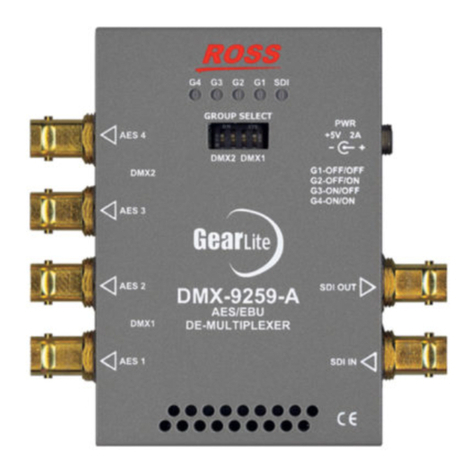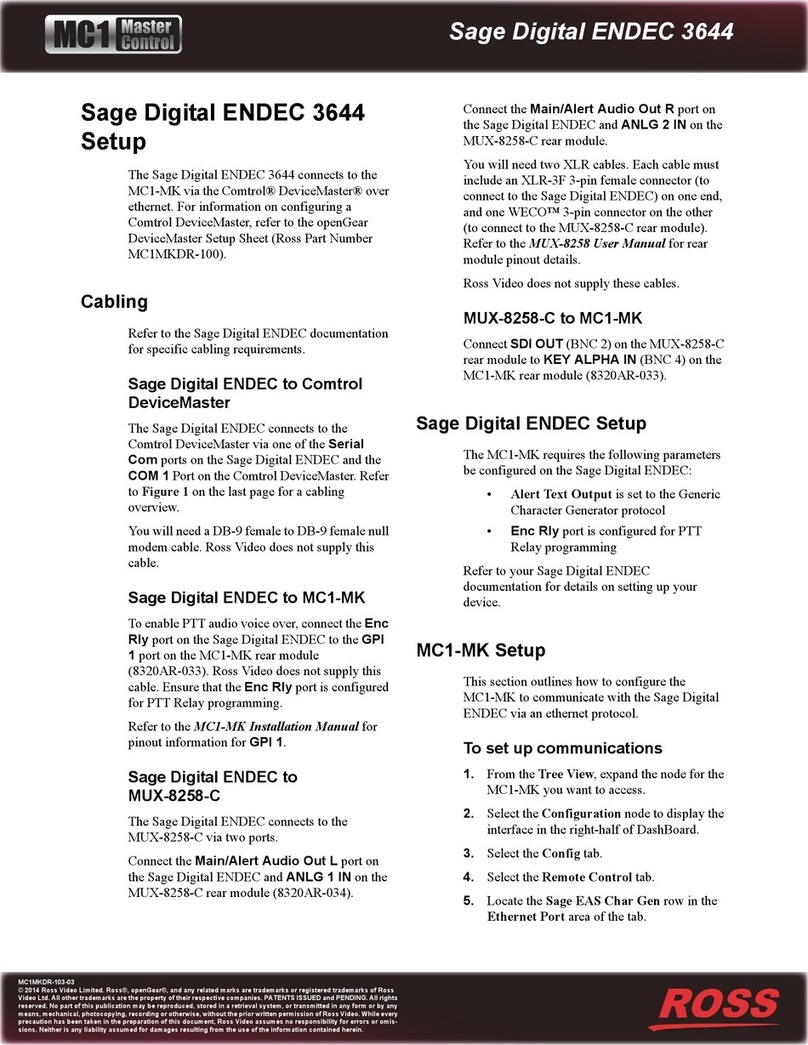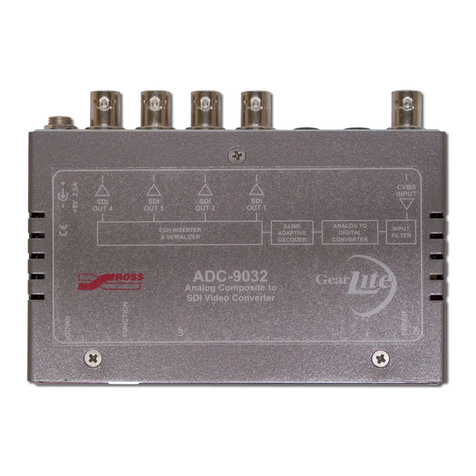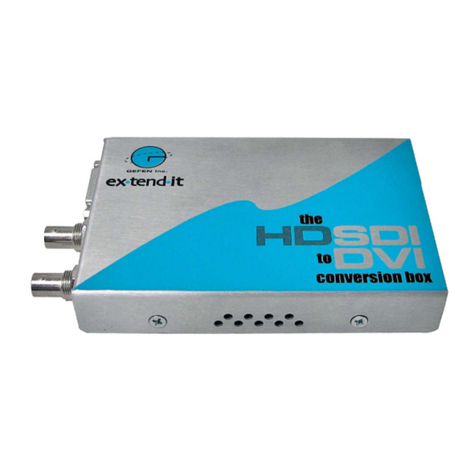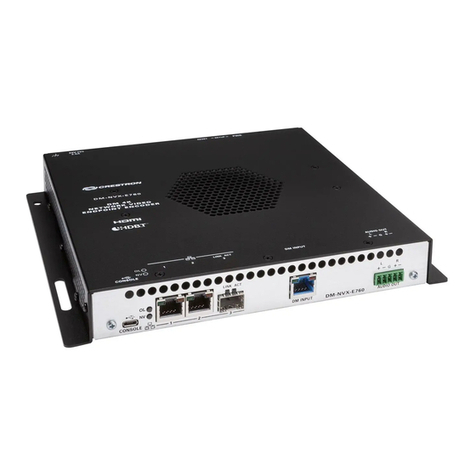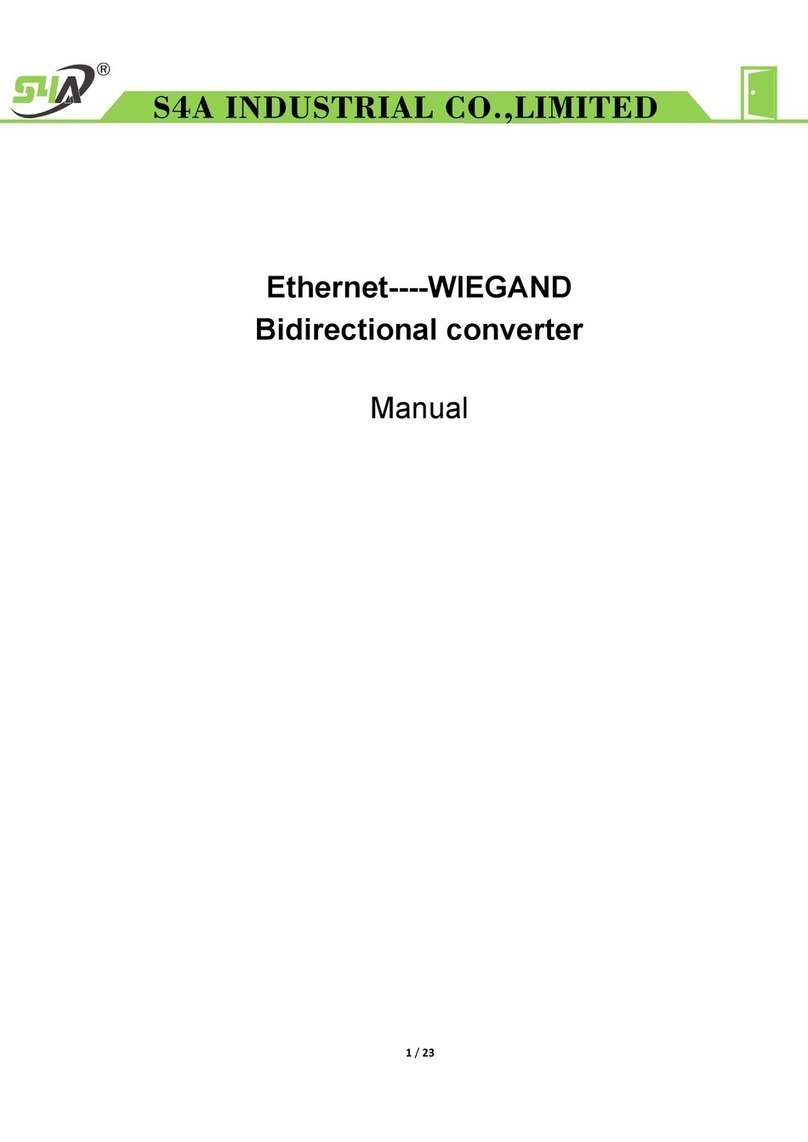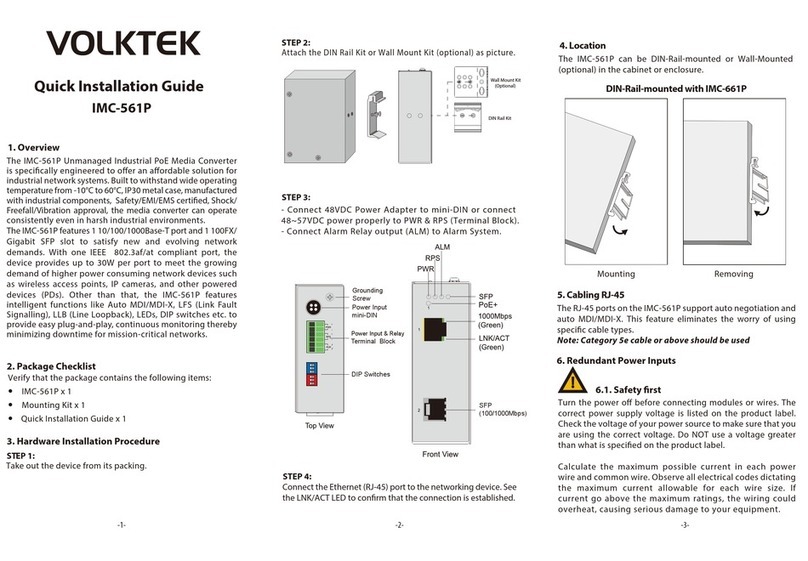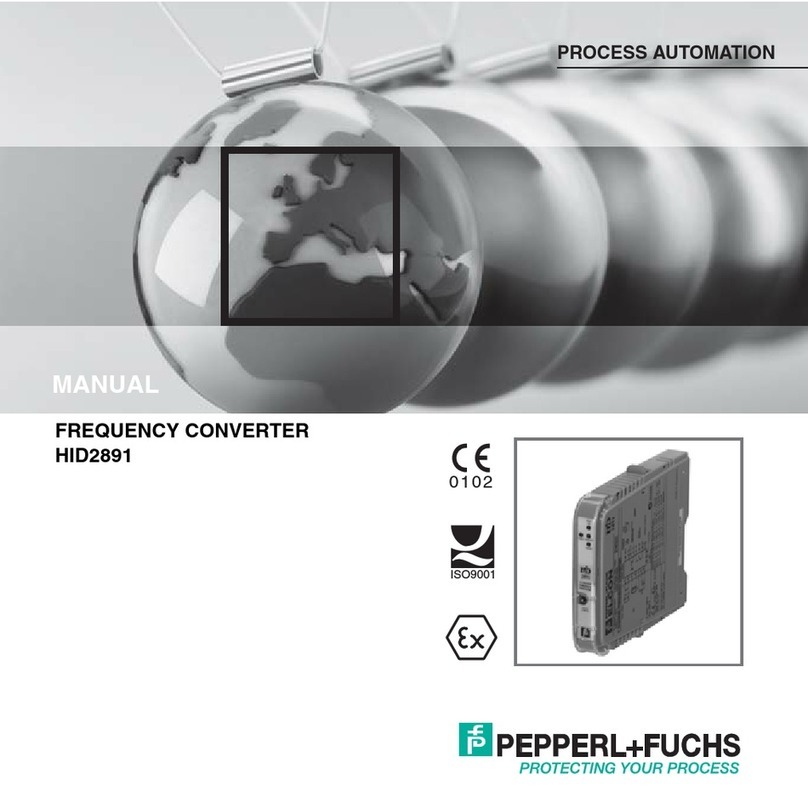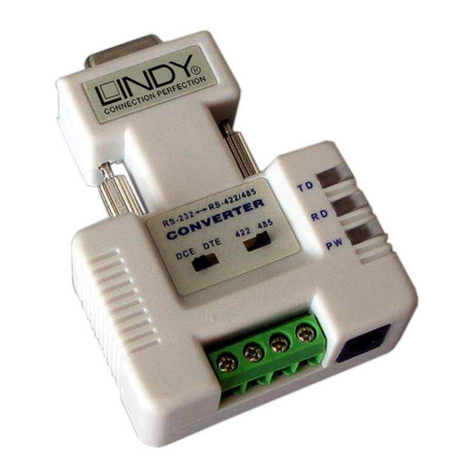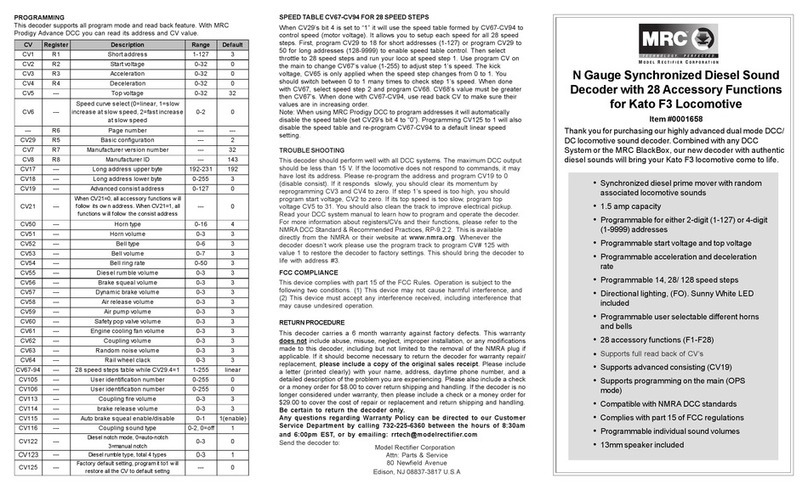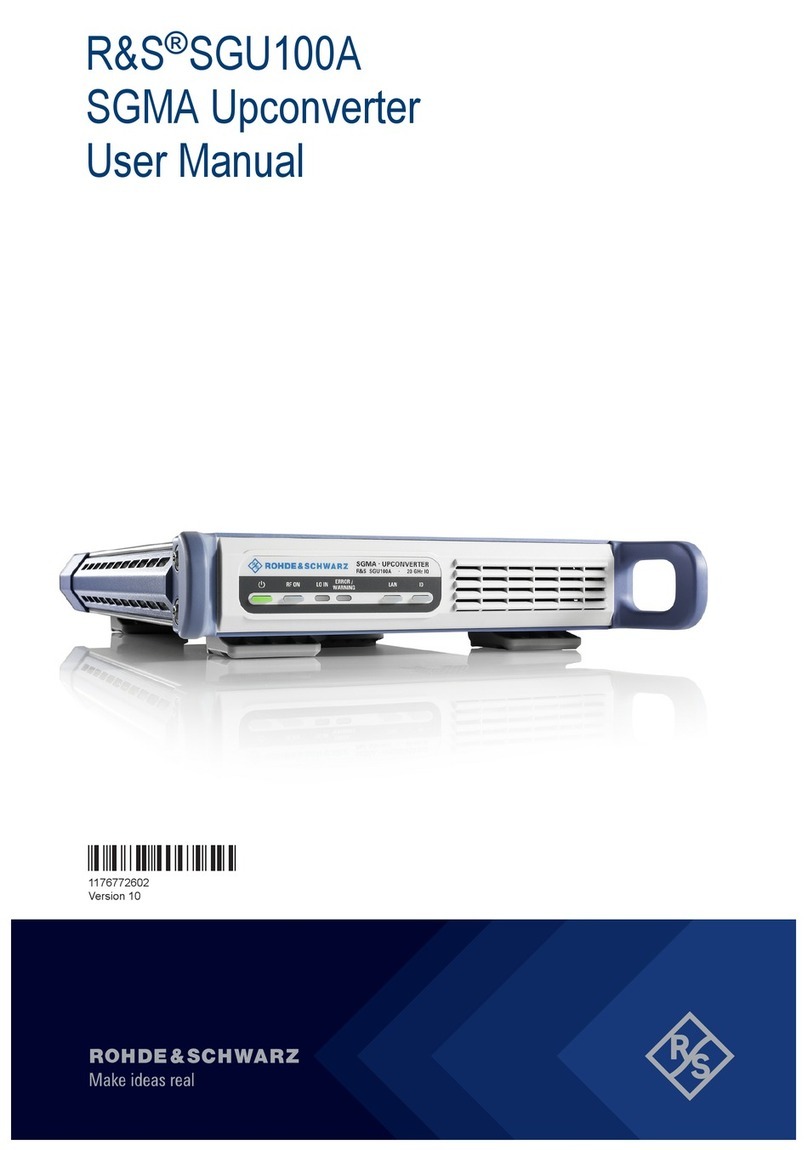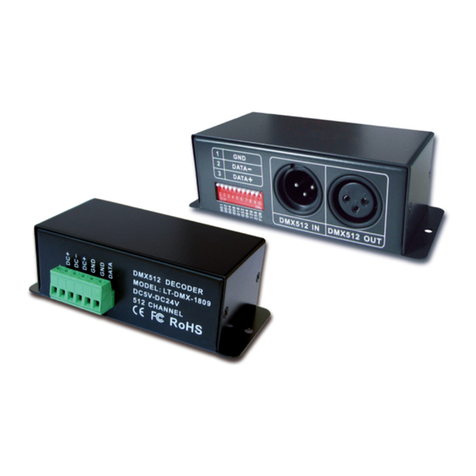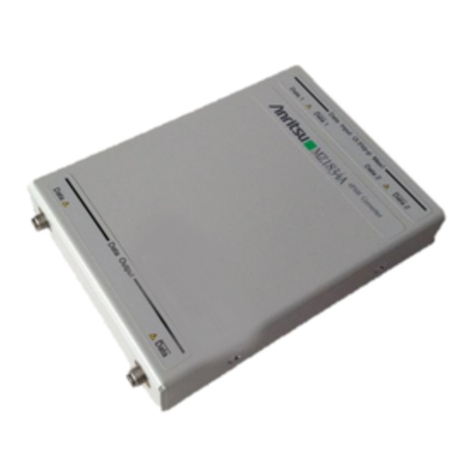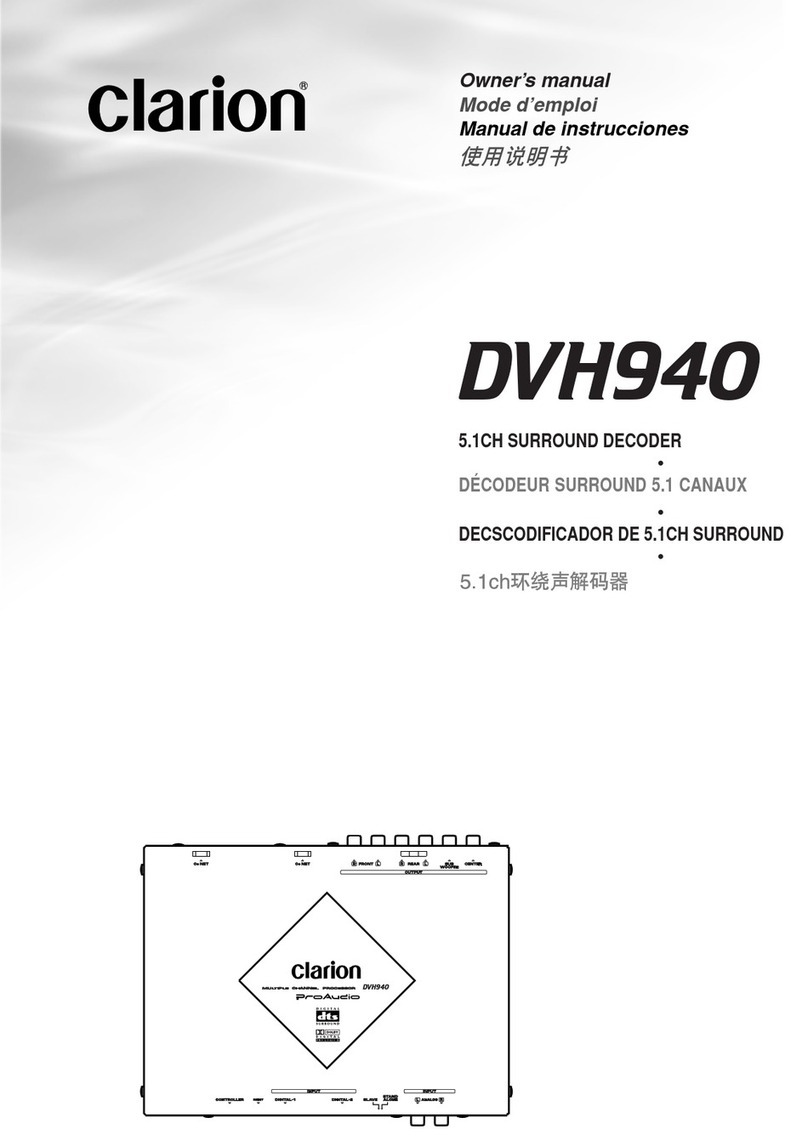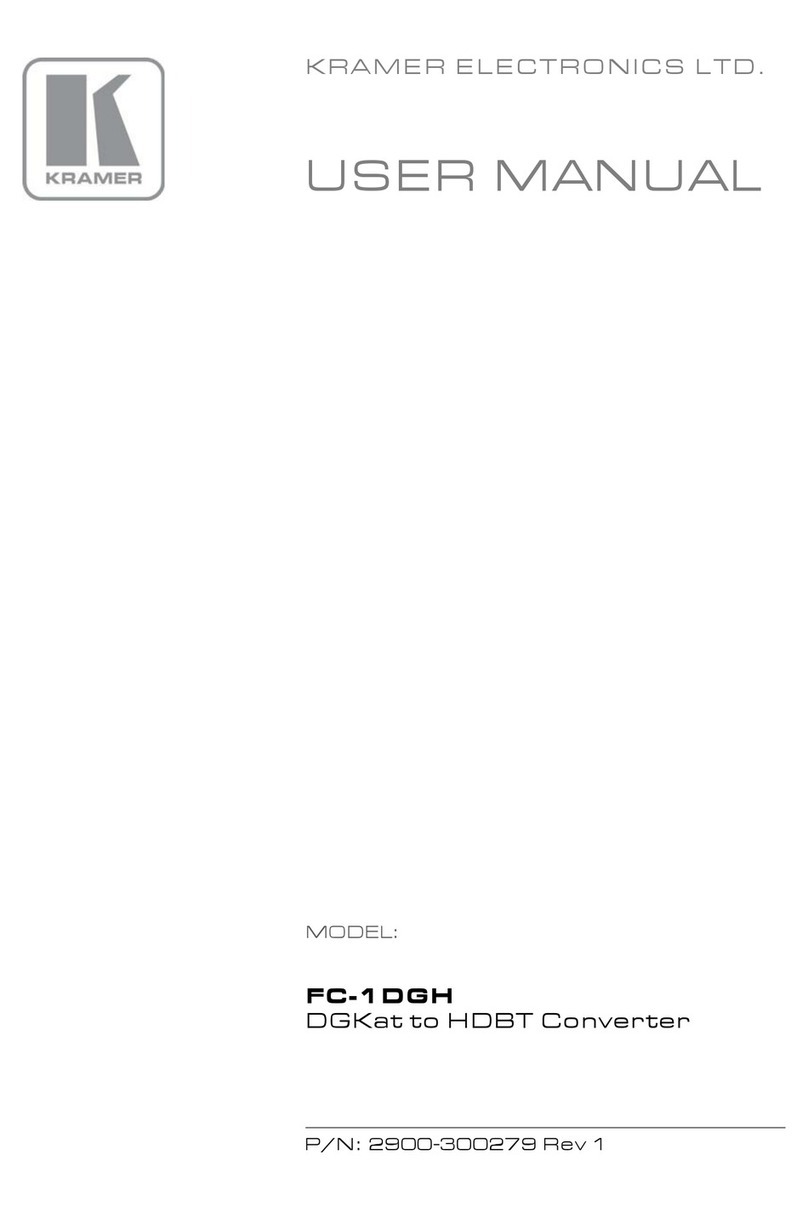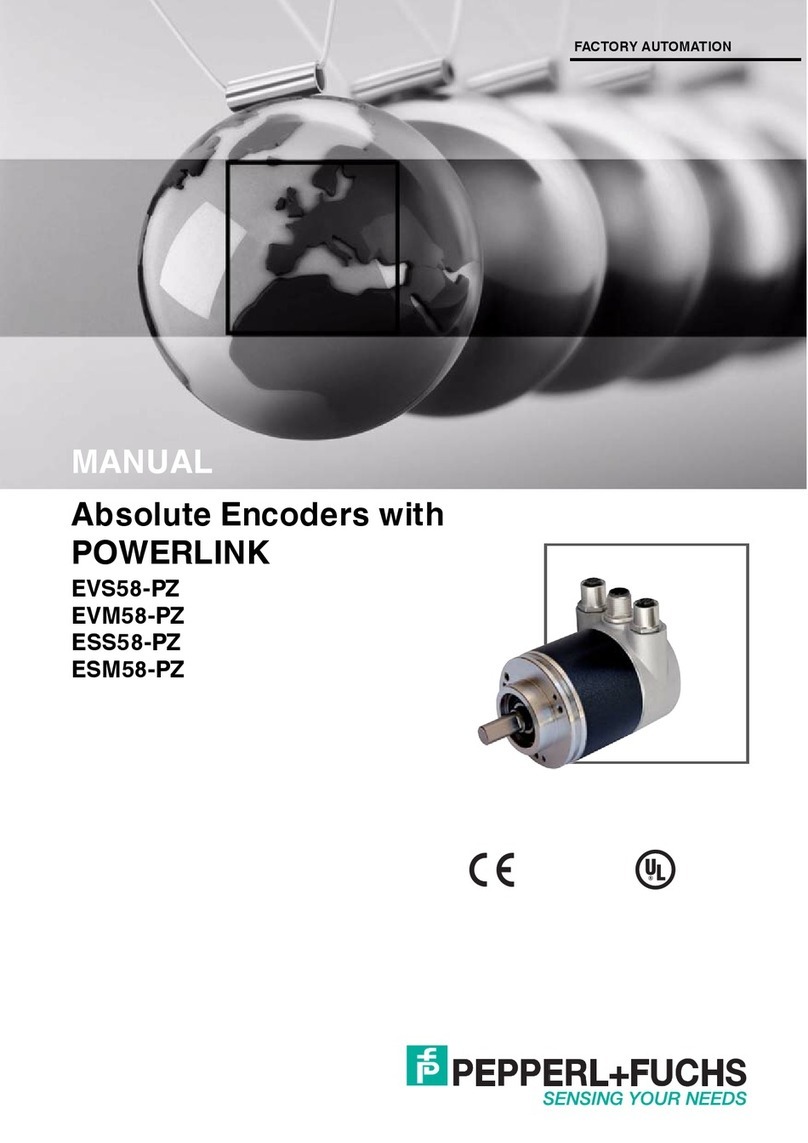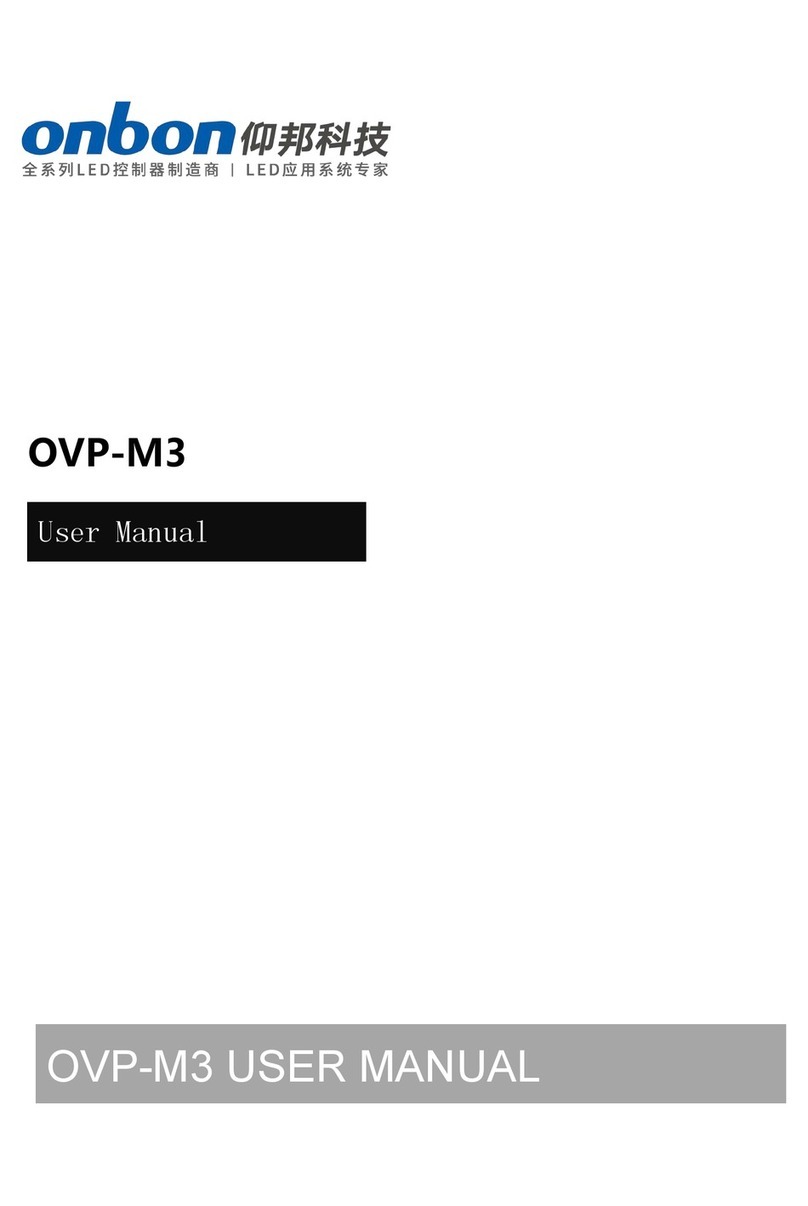Ross nielsen NWE-IP User manual

NWE-IP User Guide

Thank You for Choosing Ross
You've made a great choice. We expect you will be very happy with your purchase of Ross Technology.
Our mission is to:
1. Provide a Superior Customer Experience
• offer the best product quality and support
2. Make Cool Practical Technology
• develop great products that customers love
Ross has become well known for the Ross Video Code of Ethics. It guides our interactions and
empowers our employees. I hope you enjoy reading it below.
If anything at all with your Ross experience does not live up to your expectations be sure to reach out to
us at solutions@rossvideo.com.
David Ross
CEO, Ross Video
Ross Video Code of Ethics
Any company is the sum total of the people that make things happen. At Ross, our employees are a
special group. Our employees truly care about doing a great job and delivering a high quality customer
experience every day. This code of ethics hangs on the wall of all Ross Video locations to guide our
behavior:
1. We will always act in our customers’ best interest.
2. We will do our best to understand our customers’ requirements.
3. We will not ship crap.
4. We will be great to work with.
5. We will do something extra for our customers, as an apology, when something big goes wrong and
it's our fault.
6. We will keep our promises.
7. We will treat the competition with respect.
8. We will cooperate with and help other friendly companies.
9. We will go above and beyond in times of crisis. If there's no one to authorize the required action in
times of company or customer crisis - do what you know in your heart is right. (You may rent
helicopters if necessary.)

NWE-IP · User Guide
• Ross Part Number: 3900DR-204-05
• Release Date: December 1, 2020.
The information contained in this Guide is subject to change without notice or obligation.
Copyright
©2020 Ross Video Limited, Ross®, and any related marks are trademarks or registered trademarks of Ross Video
Limited. All other trademarks are the property of their respective companies. PATENTS ISSUED and PENDING.
All rights reserved. No part of this publication may be reproduced, stored in a retrieval system, or transmitted in any
form or by any means, mechanical, photocopying, recording or otherwise, without the prior written permission of
Ross Video. While every precaution has been taken in the preparation of this document, Ross Video assumes no
responsibility for errors or omissions. Neither is any liability assumed for damages resulting from the use of the
information contained herein.
©2020 The Nielsen Company. All rights reserved.
Patents
Patent numbers US 7,034,886; US 7,508,455; US 7,602,446; US 7,802,802 B2; US 7,834,886; US 7,914,332; US
8,307,284; US 8,407,374 B2; US 8,499,019 B2; US 8,519,949 B2; US 8,743,292 B2; GB 2,419,119 B; GB
2,447,380 B; and other patents pending.
Notice
The material in this manual is furnished for informational use only. It is subject to change without notice and should
not be construed as commitment by Ross Video Limited. Ross Video Limited assumes no responsibility or liability
for errors or inaccuracies that may appear in this manual.
Safety Notices
Refer to the “Important Regulatory and Safety Notices” document that accompanied your product.
EMC Notices
US FCC Part 15
This equipment has been tested and found to comply with the limits for a class A Digital device, pursuant to part 15
of the FCC Rules.
These limits are designed to provide reasonable protection against harmful interference when the equipment is
operated in a Commercial environment. This equipment generates, uses, and can radiate radio frequency energy
and, if not installed and used in accordance with the instruction manual, may cause harmful interference to radio
communications. Operation of this equipment in a residential area is likely to cause harmful interference in which
case the user will be required to correct the interference at his own expense.
Canada
This Class “A” digital apparatus complies with Canadian ICES-003 and part 15 of the FCC Rules.
Notice — Changes or modifications to this equipment not expressly approved by Ross Video Ltd.
could void the user’s authority to operate this equipment.

Cet appareil numerique de la classe “A” est conforme a la norme NMB-003 du Canada.
European Union
This equipment is in compliance with the essential requirements and other relevant provisions established under
regulation (EC) No 765/2008 and Decision No 768/2008/EC referred to as the “New Legislative Framework”.
Australia/New Zealand
This equipment is in compliance with the provisions established under the Radiocommunications Act 1992 and
Radiocommunications Labeling (Electromagnetic Compatibility) Notice 2008.
International
This equipment has been tested under the requirements of CISPR 22:2008 or CISPR 32:2015 and found to comply
with the limits for a Class A Digital device.
Maintenance/User Serviceable Parts
Routine maintenance to this product is not required. This product contains no user serviceable parts. If the module
does not appear to be working properly, please contact Technical Support using the numbers listed under the
“Contact Us” section of this manual. All openGear products are covered by a generous 3-year warranty and will be
repaired without charge for materials or labor within this period. See the “Warranty and Repair Policy” section in
this manual for details.
Environmental Information
The equipment may contain hazardous substances that could impact health and the environment.
To avoid the potential release of those substances into the environment and to diminish the need for the extraction
of natural resources, Ross Video encourages you to use the appropriate take-back systems. These systems will reuse
or recycle most of the materials from your end-of-life equipment in an environmentally friendly and health
conscious manner.
The crossed-out wheeled bin symbol invites you to use these systems.
If you need more information on the collection, reuse, and recycling systems, please contact your local or regional
waste administration. You can also contact Ross Video for more information on the environmental performances of
our products.
Warning — This equipment is compliant with Class A of CISPR 32. In a residential environment this
equipment may cause radio interference.
Notice — This is a Class A product. In domestic environments, this product may cause radio
interference, in which case the user may have to take adequate measures.

Company Address
Ross Video Limited
8 John Street
Iroquois, Ontario
Canada, K0E 1K0
Ross Video Incorporated
P.O. Box 880
Ogdensburg, New York
USA 13669-0880
General Business Office: (+1) 613 652 4886
Fax: (+1) 613 652 4425
Technical Support: (+1) 613 652 4886
After Hours Emergency: (+1) 613 349 0006
E-mail (Technical Support): [email protected]
E-mail (General Information): solutions@rossvideo.com
Website: http://www.rossvideo.com
The Nielsen Company
Encoder Support Group
501 Brooker Creek Blvd.
Oldsmar, Florida, USA 34677
Phone: (+1) 800 • 537 • 4872
E-mail: enc[email protected]
Website: http://www.nielsen.com


NWE-IP User Guide (v5.0) Contents • i
Contents
Introduction 11
Related Publications ...............................................................................................................................................11
Documentation Conventions .................................................................................................................................. 11
Interface Elements ............................................................................................................................................... 11
User Entered Text ...............................................................................................................................................12
Referenced Guides .............................................................................................................................................. 12
Menu Sequences ..................................................................................................................................................12
Important Instructions .........................................................................................................................................12
Contacting Ross Video Technical Support ............................................................................................................12
Contacting the Nielsen Encoder Support Group ....................................................................................................12
Before You Begin 13
Overview ................................................................................................................................................................ 13
Functional Block Diagram .....................................................................................................................................13
Features ..................................................................................................................................................................13
DashBoard Interfaces ............................................................................................................................................. 14
Planning the Installation ........................................................................................................................................ 14
What are Receivers, Senders, and Streams? ..........................................................................................................14
Configuration Overview ........................................................................................................................................15
Audio Channel Mapping Example .........................................................................................................................15
Integration Example 17
Basic Physical Setup ...........................................................................................................................................17
Configure the Initial Network Settings ...............................................................................................................18
Configure the Basic Settings of the NWE-IP ...................................................................................................... 18
Connect to the 5.1 and Stereo Streams with Different Channel Counts ............................................................. 18
Map the Sources to a Watermark Engine ............................................................................................................18
Hardware Overview 19
Front Panel Overview ............................................................................................................................................19
Rear Panel Overview ............................................................................................................................................. 19
Physical Installation 21
Installing the NWE-IP in a Rack Frame ................................................................................................................ 21
Connecting the Power Supplies .............................................................................................................................21
Cabling 23
Connecting to a Network .......................................................................................................................................23
Before You Begin ............................................................................................................................................... 23
Connecting to your Facility Network ..................................................................................................................23
Connecting to the PTP Grandmaster ...................................................................................................................23
Cabling for Protection Switching ........................................................................................................................24
Connecting Peripheral Devices ..............................................................................................................................24
Initial Connection 27
Physical Connections to the NWE-IP .................................................................................................................... 27
Configuring the Initial Network Settings ............................................................................................................... 27
Before You Begin ............................................................................................................................................... 27
Using DHCP .......................................................................................................................................................27

ii • Contents NWE-IP User Guide (v5.0)
Manually Adding the NWE-IP to the Tree View ...................................................................................................28
Using DashBoard 29
Launching DashBoard ............................................................................................................................................29
Accessing the NWE-IP Interfaces in DashBoard ...................................................................................................29
Updating the Network Settings 33
Network Connections to the NWE-IP ....................................................................................................................33
Updating the Gb1 Port Settings ..............................................................................................................................33
Updating the NET1 Port Settings ...........................................................................................................................34
Setting up Protection Switching .............................................................................................................................34
Before You Begin ................................................................................................................................................34
Configuring the NWE-IP for Protection Switching ............................................................................................34
Configuring the Timing Settings 37
Configuring the PTP Settings .................................................................................................................................37
Configuring the AES67 Receiver 39
Overview ................................................................................................................................................................39
Configure the Global AES67 Receiver Settings ....................................................................................................39
Creating Network Stream Groups for the AES67 Receiver ...................................................................................40
Mapping the Audio Channels to the AES67 Receiver ........................................................................................41
Routing a Network Stream Group to a Watermark Encoder Channel ...................................................................43
Enabling the Watermark Encoders 45
Overview ................................................................................................................................................................45
Changing the Watermark Encoder Channel Names ...............................................................................................45
Configuring the Global Encoder Settings ..............................................................................................................46
Configuring a Watermark Encoder Channel ..........................................................................................................46
Configuring the AES67 Senders 49
Overview ................................................................................................................................................................49
Configuring the Global AES67 Sender Settings ....................................................................................................49
Mapping the Audio Channels for the AES67 Sender ............................................................................................50
Third-Party Protocols 53
Ember+ Support .....................................................................................................................................................53
Audio Channel Mapping for Ember+ ..................................................................................................................53
NMOS Support .......................................................................................................................................................54
Upgrading the Software 57
DashBoard Interface Overview 59
Global Interface ......................................................................................................................................................59
Ethernet Tab ........................................................................................................................................................59
Timing Tab ..........................................................................................................................................................60
About Tab ............................................................................................................................................................62
AES67 Receiver Interface ......................................................................................................................................62
Network Streams Tab ..........................................................................................................................................62
Connections Tab ..................................................................................................................................................64
Status Tab ............................................................................................................................................................66
Device Setup Tab ................................................................................................................................................67
Nielsen Watermark Encoder Interface ...................................................................................................................67

NWE-IP User Guide (v5.0) Contents • iii
Watermark Table Tab .........................................................................................................................................68
Status Tab ............................................................................................................................................................68
Device Setup Tab ................................................................................................................................................69
AES67 Sender Interface .........................................................................................................................................69
Network Streams Tab .......................................................................................................................................... 70
Status Tab ............................................................................................................................................................71
Device Setup Tab ................................................................................................................................................71
NMOS Interface .....................................................................................................................................................72
Node Tab .............................................................................................................................................................72
Technical Specifications 75
Gb1 Specifications .................................................................................................................................................75
NET1, NET2 Specifications ..................................................................................................................................75
USB Port Specifications ........................................................................................................................................ 75
Environment ...........................................................................................................................................................75
Power .....................................................................................................................................................................75
Service Information 77
Warranty and Repair Policy ................................................................................................................................... 77
Glossary 79

iv • Contents NWE-IP User Guide (v5.0)

NWE-IP User Guide (v5.0) Introduction • 11
Introduction
This guide covers the installation, configuration, and use of the NWE-IP. The following chapters are included:
• “Introduction” summarizes the guide and provides important terms, and conventions.
• “Before You Begin” summarizes the features of the NWE-IP.
• “Integration Example” provides a possible implementation of the NWE-IP in a facility work-flow.
• “Hardware Overview” presents information on the NWE-IP hardware.
• “Physical Installation” provides additional information for installing the NWE-IP, and DashBoard before you
can proceed to cabling and configuring your NWE-IP.
• “Cabling” outlines how to connect to your facility network. Information is also given about connecting
peripheral devices you will need for initial setup.
• “Initial Connection” provides instructions for configuring the initial IP address for the NWE-IP.
• “Using DashBoard” provides instructions for launching DashBoard, and accessing the NWE-IP interfaces in
DashBoard.
• “Updating the Network Settings” provides instructions for configuring the RJ45 ports of the NWE-IP for
communication with your facility network and streaming devices.
• “Configuring the PTP Settings” provides instructions for configuring the NWE-IP to use Precision Time
Protocol, and specifying a system clock reference source.
• “Configuring the AES67 Receiver” outlines the steps required to configuring the AES67 receiver streams on
the NWE-IP.
• “Enabling the Watermark Encoders” outlines the steps required to configuring and enabling up to four
watermark encoder channels.
• “Configuring the AES67 Senders” outlines the steps required to configuring the AES67 sender streams on the
NWE-IP.
• “Third-Party Protocols” summarizes how the NWE-IP implements third-party protocols such as Ember+.
• “Upgrading the Software” provides instructions on how to upgrade the NWE-IP software via DashBoard.
• “DashBoard Interface Overview” summarizes the menus and parameters of the NWE-IP tabs in DashBoard.
• “Technical Specifications” provides the specifications for the NWE-IP.
• “Service Information” provides information on the warranty and repair policy for your NWE-IP.
• “Glossary”provides a list of terms used throughout this guide.
Related Publications
It is recommended to consult the following Ross documentation before installing and configuring your NWE-IP:
•DashBoard User Manual, Ross Part Number: 8351DR-004
•NWE-IP Quick Start Guide, Ross Part Number: NWEIPDR-002
Documentation Conventions
Special text formats are used in this guide to identify parts of the user interface, text that a user must enter, or a
sequence of menus and sub-menus that must be followed to reach a particular command.
Interface Elements
Bold text is used to identify a user interface element such as a dialog box, menu item, or button. For example:
In the Network tab, click Apply.

12 • Introduction NWE-IP User Guide (v5.0)
User Entered Text
Courier text is used to identify text that a user must enter. For example:
In the Language box, enter English.
Referenced Guides
Text set in bold and italic represent the titles of referenced guides, manuals, or documents. For example:
For more information, refer to the DashBoard User Manual.
Menu Sequences
Menu arrows are used in procedures to identify a sequence of menu items that you must follow. For example, if a
step reads “File > Save As,” you would click the File menu and then click Save As.
Important Instructions
Star icons are used to identify important instructions or features. For example:
Contact your IT department before connecting to your facility network to ensure that there are no conflicts. They
will provide you with an appropriate value for the IP Address, Subnet Mask, and Gateway for your device.
Contacting Ross Video Technical Support
At Ross Video, we take pride in the quality of our products, but if problems occur, help is as close as the nearest
telephone.
Our 24-hour Hot Line service ensures you have access to technical expertise around the clock. After-sales service
and technical support is provided directly by Ross Video personnel. During business hours (Eastern Time),
technical support personnel are available by telephone. After hours and on weekends, a direct emergency technical
support phone line is available. If the technical support person who is on call does not answer this line immediately,
a voice message can be left and the call will be returned shortly. This team of highly trained staff is available to
react to any problem and to do whatever is necessary to ensure customer satisfaction.
•Technical Support: (+1) 613-652-4886
•After Hours Emergency: (+1) 613-349-0006
•E-mail: [email protected]
•Website: http://www.rossvideo.com
Contacting the Nielsen Encoder Support Group
•Support: (+1) 800-537-4872
•E-mail: [email protected]
•Website: http://www.nielsen.com

NWE-IP User Guide (v5.0) Before You Begin • 13
Before You Begin
If you have questions pertaining to the operation of NWE-IP, contact us at the numbers listed in the section
“Contacting Ross Video Technical Support”. Our technical staff is always available for consultation, training, or
service.
Overview
The NWE-IP is a fully compliant SMPTE ST2110-30 Nielsen Watermark encoder that will add watermark
information to track a video program through many national distribution systems. The information that is encoded
is used to uniquely identify the content of the creative and, if desired, track the transport path of the creative through
any other point in the distribution system that does watermarking. This patented ability to add information at
various stages is called multi-level encoding.
The encoded information typically consists of:
•Source Identification Number (SID) — A unique number is assigned to each source of creative.
Post-production facilities that serve more than one Automated Measurement of Lineups (AMOL) client may use
a separate SID for each client.
•Date/Time — The local time that the creative was encoded. The NWE-IP uses the Nielsen Audio Encoding
System (NAES), Nielsen Watermarks (NW) and Critical Band Encoding Technology (CBET) audio encoder.
Audio is encoded on a continuous basis. The data is embedded in an audio signal by performing minor
modification of selected spectral frequency components of successive blocks of audio data.
Functional Block Diagram
Figure 2.1 provides a general functional block diagram of the NWE-IP.
Figure 2.1 Functional Block Diagram
Features
The NWE-IP includes the following features:
• 4 independent Nielsen watermark engine with converged encoding support (NAES only, CBET only, or NAES
and CBET)
• Support for up to 32 audio channels
› 1ms (or 125µs) packet time with flow containing up to 8 channels
› 48KHz L24 audio
• Provides protection switching using hitless merge of all streams per SMPTE ST 2022-7
STREAM A
CH 1, 2, 3 ...
STREAM B
CH 1, 2, 3 ...
Watermark
Engine 1
Watermark
Engine 4
SMPTE
ST2110-30
Decoder
Network Stream
Group #
5.1 and/or Stereo
Network Stream
Group 1
5.1 and/or Stereo STREAM C
CH 1, 2, 3 ...
STREAM D
CH 1, 2, 3 ...
Audio CH Cluster 1
5.1 NW/CBET
or Stereo
Audio CH Cluster n
5.1 NW/CBET
or Stereo
SMPTE
ST2110-30
Encoder

14 • Before You Begin NWE-IP User Guide (v5.0)
• Support for the following PTP profiles:
› SMPTE ST 2059 profile
› IEEE 1588 default profile
› AES67 profile
• Ember+ (BESS 1.2) connection control
• Support for NMOS IS-04 and IS-05
• RTP timestamp preserve or re-stamp
• Latency < 30ms + link offset
• Independent management and media 1000 BaseT Gigabit Ethernet
• Management under DashBoard control
DashBoard Interfaces
The NWE-IP requires an Ethernet network connection between it and a computer that will run the DashBoard
client. The DashBoard client software enables you to monitor and control DashBoard Connect compatible devices
from a computer.
The NWE-IP includes DashBoard interfaces for configuration and operation. The interfaces are accessed by
expanding the NWE-IP node in the DashBoard Tree View and selecting the appropriate sub-node.
For More Information on...
• displaying the DashBoard interfaces, refer to the chapter “Using DashBoard” on page 29.
Planning the Installation
Before inserting the NWE-IP into your program path, determine if this replaces a current hardware solution or will
be used for a new service. If this will be used for a new service or distribution path, you will need to obtain a Source
Identification (SID) code from Nielsen. The SID is a unique identifier assigned to each source of creative.
Contact the Nielsen Encoder Support Group to obtain a SID code by telephone at 1-800-537-4872 or by e-mail at
[email protected]. Be prepared to give them the serial number of your NWE-IP.
The best insertion point for the NWE-IP is downstream of all switchers, routers, and processing equipment but
before any Dolby® E or Dolby® AC-3 encoders. To ensure that the coding remains in the audio signals, the
NWE-IP should be downstream of any equipment that may strip or modify audio. Contact Nielsen if you are unsure
about the proper system installation.
What are Receivers, Senders, and Streams?
The following terms are used throughout this user guide:
Device
A physical, virtual, or software application that may include multiple sources, destinations, senders, or receivers.
Essence
A single elementary logical media signal. An audio essence is a single audio (mono) channel.
Flow
The continuous raw media content. It can contain more than one essence (e.g. an audio flow can contain multiple
channels).

NWE-IP User Guide (v5.0) Before You Begin • 15
A flow is independent of the transport protocol. For example, 48kHz LPCM audio is a flow; AES67 is one type of
stream which can carry the flow.
Flows cannot generally be passed around natively, and need to be encapsulated in a stream. Flows from the same
source are considered “editorially equivalent”, but may be encoded differently.
Receiver
An element within a device that receives exactly one stream, which contains one flow from a network.
Sender
An element within a device which presents exactly one flow, packaged as a stream onto a network.
Stream
One flow, encapsulated within a transport protocol (e.g. SMPTE ST 2110-30 Audio (AES67)).
Network Stream Group
A network stream group allows you to create a grouping of streams on the network into a unit that can be mapped to
a Watermark Encoder channel. Network stream groups are required when:
• the output has more channels than a stream on the network and the user wants to drive all channels;
• the user wants to perform complicated audio shuffling
Configuration Overview
Figure 2.2 provides a generalized work-flow of installing and configuring your NWE-IP.
Figure 2.2 Configuration Work-flow
Audio Channel Mapping Example
Figure 2.2 provides a generalized work-flow of mapping eight channels from an AES67 device to different groups.
Configure
the AES67
Receiver
Streams
Enable
the
Watermark
Encoder
Channels
Configure
the AES67
Sender
Streams
Route
the
Stream
Groups
Assign
IP Addresses
to the
NWE-IP
Ports

16 • Before You Begin NWE-IP User Guide (v5.0)
Figure 2.3 Example of Channel Mapping
Watermark 1
NWE-IP
Group 1
Watermark 2*
NWE-IP
Group 2
Ch1
Ch2
Ch3
Ch4
Ch5
Ch6
Ch7
Ch8
AES67 Device
IP: 239.1.1.1
NWE-IP
Group 1 - Stream 1
5.1 Surround
NWE-IP
Group 2 - Stream 1
Stereo
AES67 Input
AES67 Output
*The number of Watermark Encoders is dependent on the number of encoders enabled for the NWE-IP.
AES67 Sender Stream 1 - Ch1
AES67 Sender Stream 1 - Ch2
AES67 Sender Stream 1 - Ch3
AES67 Sender Stream 1 - Ch4
AES67 Sender Stream 1 - Ch5
AES67 Sender Stream 1 - Ch6
AES67 Sender Stream 1 - Ch7
AES67 Sender Stream 1 - Ch8
AES67
Device
IP: 239.4.4.4
AES67
Device
IP: 239.5.5.5

NWE-IP User Guide (v5.0) Integration Example • 17
Integration Example
A user is a broadcast engineer that wants to watermark the transmission path using either Nielsen converged
watermarks (NW/NAES/CBET) or just CBET. Their facility is an IP infrastructure with the following challenges:
• a requirement to synchronize the unit time to the house Grandmaster timing source
• includes SMPTE ST-2110 streams with different channel counts to handle Stereo and 5.1
• the local program is stereo and the network program is 5.1, but there is a requirement to seamlessly switch
between the two
• a requirement to re-time the audio and video downstream from the NWE-IP to address possible latency
Figure 3.1 Example Work-flow
Basic Physical Setup
The user needs to physically install the NWE-IP and ensure the following tasks are performed:
1. Physically install the NWE-IP in a rack frame. Refer to the NWE-IP Quick Start Guide.
2. Cable the two Ethernet connections. Refer to “Connecting to a Network” on page 23.
3. Power the two connections. Refer to “Connecting the Power Supplies” on page 21.
4. External equipment (e.g. monitor, keyboard) required to configure the initial network settings of the NWE-IP.
Refer to “Connecting Peripheral Devices” on page 24.
SDI
SMPTE 2010-20 (Video)
SMPTE 2010-30 (AES67)
SMPTE 2010-40 (ANC)
Gateway Receiver
SDI
SMPTE 2010-20 (Video)
Watermarked SMPTE 2010-30 (AES67)
SMPTE 2010-40 (ANC)
NWE-IP
Media Network Switch
PC running
DashBoard
PTP Grandmaster
246 32 10 52
DAY HR MIN
LOCK SYNC STATUS ALARM
SEC
PORT 1 PORT 2 PORT 3 PORT 4 PORT 5 PORT 6 PORT 7 PORT 8
Gateway Sender
Gb 1 Gb 2
Watermarked SMPTE 2010-30 (AES67)
SMPTE 2010-30 (AES67)

18 • Integration Example NWE-IP User Guide (v5.0)
Configure the Initial Network Settings
Next the user connects the NWE-IP to the network and ensures it can communicate with a computer running the
latest DashBoard client software. The DashBoard client software enables you to monitor, configure, and operate
your NWE-IP.
This step requires that the user configure the initial network settings for the NWE-IP as outlined in the chapter
“Initial Connection” on page 27.
Configure the Basic Settings of the NWE-IP
The NWE-IP is now ready for configuration. To complete the setup, the user must:
1. Set up the media network by configuring the Gb1 and NET1 ports. Refer to “Updating the Gb1 Port Settings”
on page 33 and “Updating the NET1 Port Settings” on page 34.
2. Configure the PTP settings for the NWE-IP as outlined in “Configuring the PTP Settings” on page 43.
Connect to the 5.1 and Stereo Streams with Different Channel Counts
The 5.1 surround essence includes three streams with two channels, where the stereo essence is one stream of two
channels. The user needs to create a stream group for every related audio channel (e.g. stereo pair, 5.1 surround
channels) using the AES67 Receiver interface.
1. Use the AES Receiver interface to add a new group for each channel group as outlined in “Creating Network
Stream Groups for the AES67 Receiver” on page 40.
2. Configure the IP address and specify 6-channel for the stream size
If all your streams use the same number of channels, you can change the default number under the Device Setup
tab.
3. Ensure that you set the Target Type for each group to 5.1.
4. Map the audio accordingly as outlined in “Routing a Network Stream Group to a Watermark Encoder
Channel” on page 43.
Map the Sources to a Watermark Engine
Refer to “Configuring a Watermark Encoder Channel” on page 46.

NWE-IP User Guide (v5.0) Hardware Overview • 19
Hardware Overview
This chapter presents information on the NWE-IP hardware.
Front Panel Overview
This section provides a general overview of the features of the NWE-IP front panel.
Figure 4.1 NWE-IP — Front Panel (Door Removed)
1. POWER Button
This is the main power button for the NWE-IP.
2. VGA Port
Use this port to connect a monitor if you do not have access to a network with DHCP for the initial Ethernet
setup, or if you have a need to reset your NWE-IP static IP address outside of DashBoard.
3. Diagnostic Panel
This panel reports the serial number, network address mode, IP address, and net mask of the NWE-IP. Status
information on the Dell® hardware is also displayed. Refer to the Dell documentation that accompanied the
NWE-IP for details on the type of messages this panel displays.
4. USB Ports
Use each port to connect a keyboard and mouse if you do not have access to a network with DHCP for the initial
Ethernet setup, or if you have a need to reset your NWE-IP static IP address outside of DashBoard.
Rear Panel Overview
This section provides an overview of the connections and cabling designations for the NWE-IP rear panel.
Figure 4.2 NWE-IP — Rear Panel
1. VGA Port
Use this port to connect a monitor if you do not have access to a network with DHCP for the initial Ethernet
setup, or if you have a need to reset your NWE-IP static IP address outside of DashBoard. If the VGA Port on the
front panel is also connected to a monitor, this connection supersedes it.
1
Gb 1 Gb 2
5 7 86
1
2 3
4

20 • Hardware Overview NWE-IP User Guide (v5.0)
2. Gb1 Ethernet Port
This standard 10/100/1000 Base-TXRJ45 connector is used to connect the NWE-IP to your facility network.
This connector is required to bridge the external Ethernet network to the local communication bus for monitoring
and controlling the NWE-IP using DashBoard. This port is also used for software upgrades.
3. Gb2 Ethernet Port
This port is not implemented.
4. USB Port(s)
Use each port to connect a keyboard and mouse if you do not have access to a network with DHCP for the initial
Ethernet setup, or if you have a need to reset your NWE-IP static IP address outside of DashBoard.
5. NET1 Port
The NET1 port is populated with a standard 10/100/1000 Base-TXRJ45 module from the factory. This port
enables the NWE-IP to communicate with your PTP Grandmaster and act as a transmitter/receiver for network
streams.
6. NET2 Port
The NET2 port is populated with a standard 10/100/1000 Base-TXRJ45 module from the factory. This port
enables protection switching as per SMPTE ST 2022-7.
7, 8 Power Supplies
The NWE-IP comes standard with two power supplies.
Table of contents
Other Ross Media Converter manuals

Ross
Ross UltraChrome HR User manual
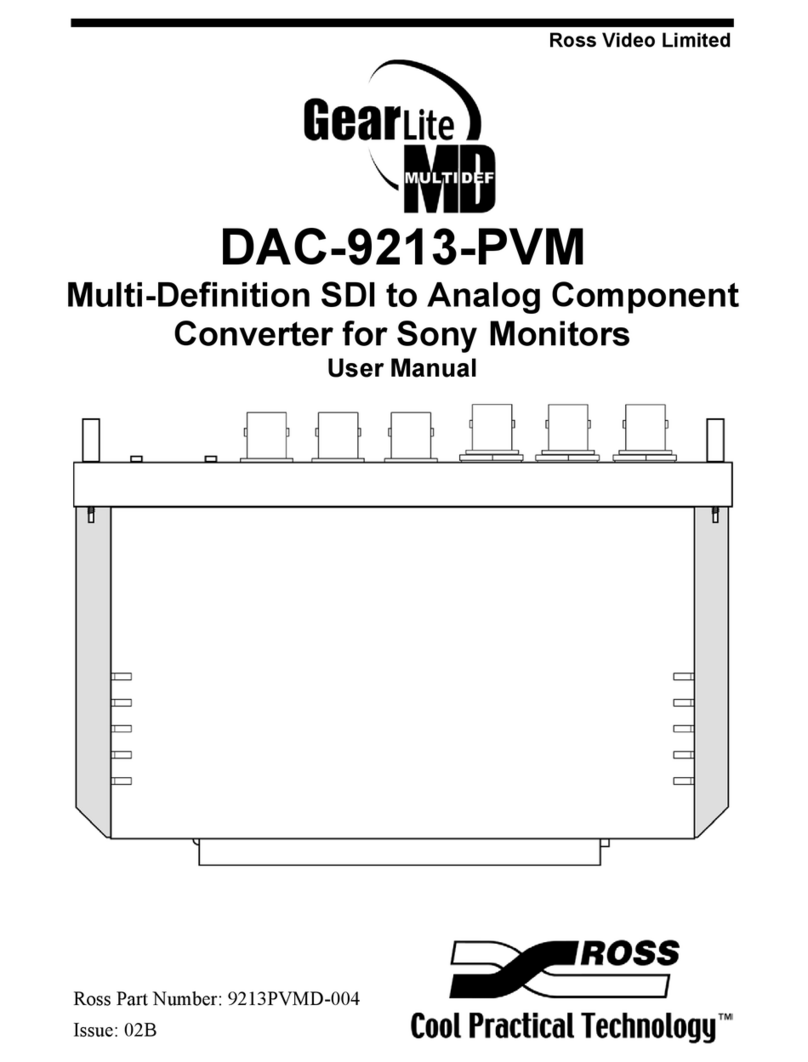
Ross
Ross DAC-9213-PVM User manual

Ross
Ross NEWT-IPX User manual
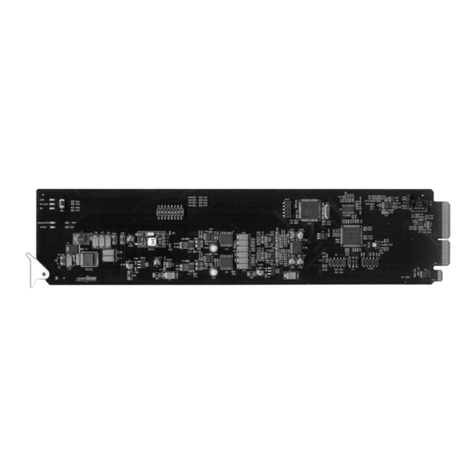
Ross
Ross openGear DAC-8416 User manual
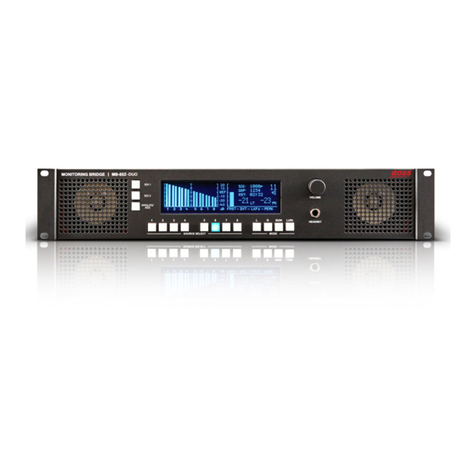
Ross
Ross MB-652-DUO User manual
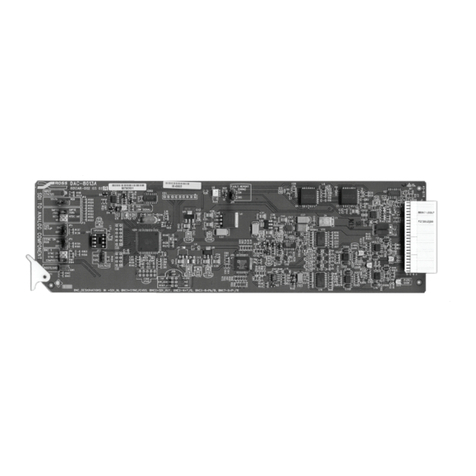
Ross
Ross DAC-8013A User manual
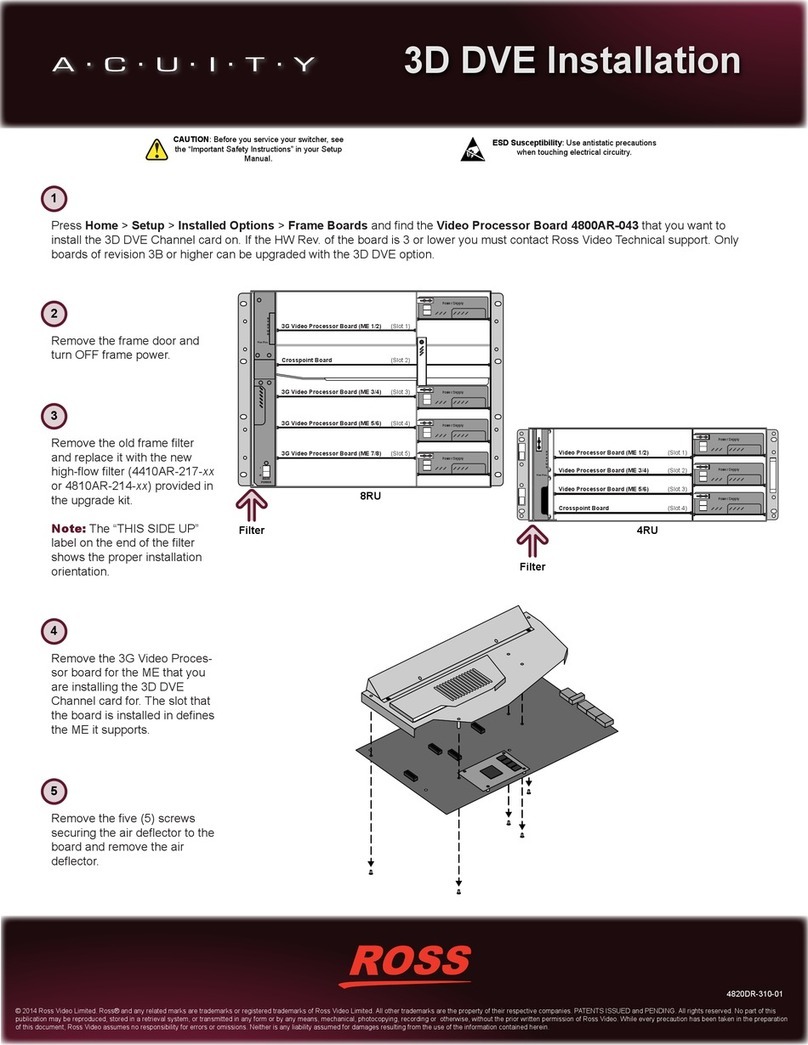
Ross
Ross ACUITY 3D DVE User manual
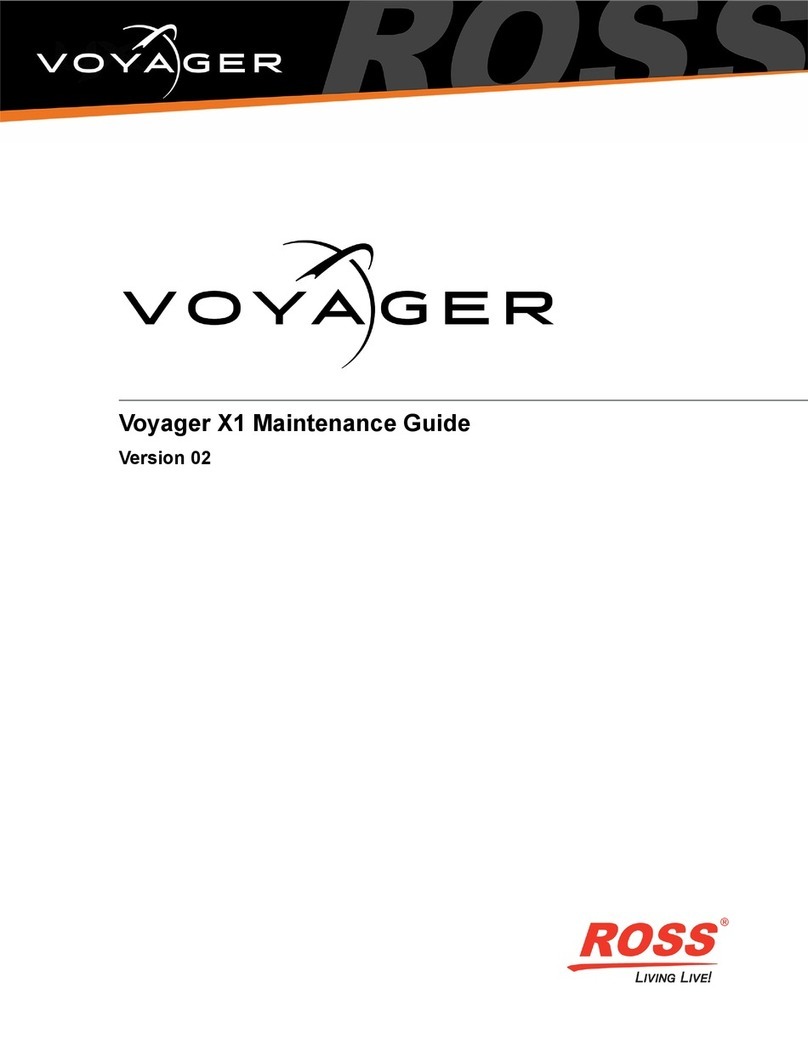
Ross
Ross YOYAGER X1 Operating manual

Ross
Ross NEWT-IPX User manual
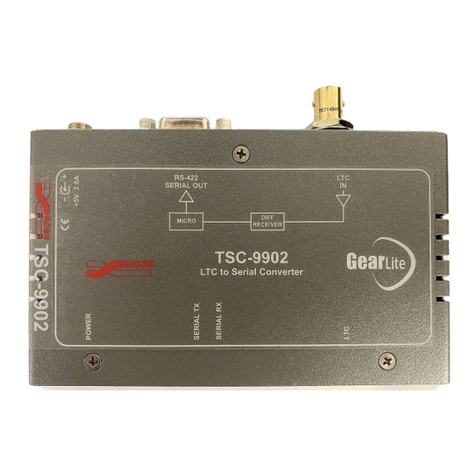
Ross
Ross GearLite TSC-9902 User manual

Ross
Ross AirCleaner-2 User manual
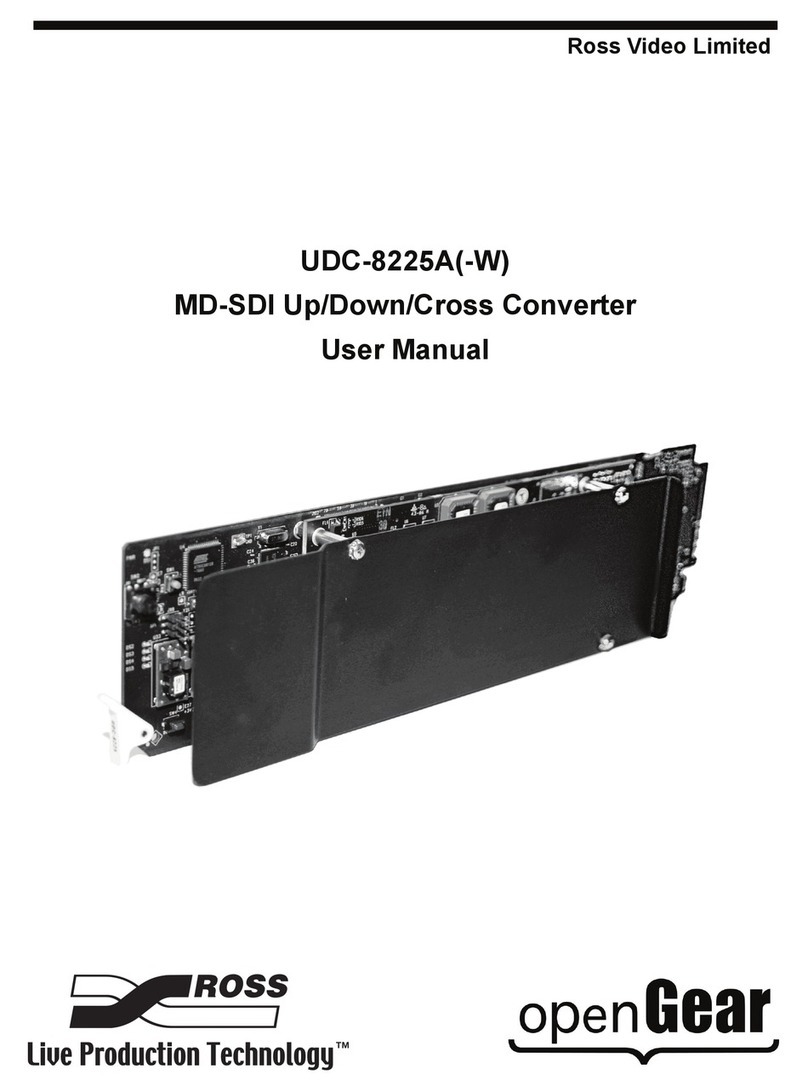
Ross
Ross openGear UDC-8225A User manual
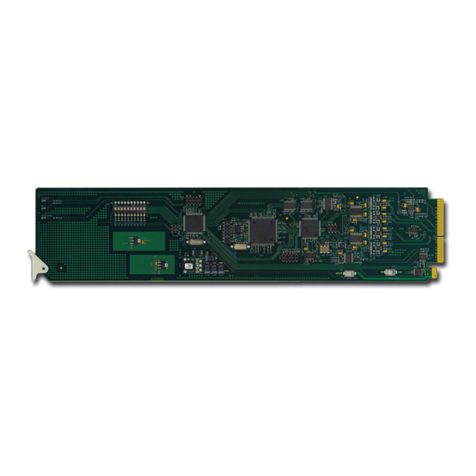
Ross
Ross openGear ADC-8434-A User manual

Ross
Ross DAC-8418-A User manual

Ross
Ross DED-8420 User manual

Ross
Ross GearLite FDR-9647-LC User manual

Ross
Ross MB-652-DUO User manual
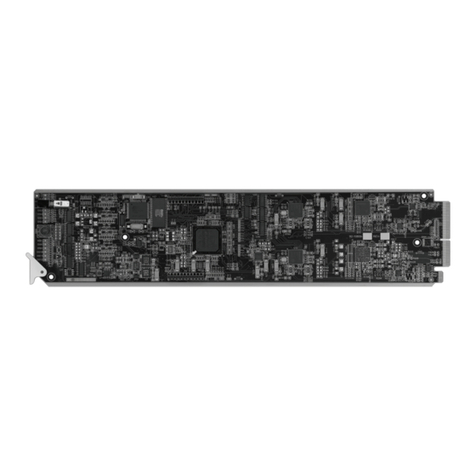
Ross
Ross ASI-310 User manual

Ross
Ross ADC-8432 User manual

Ross
Ross NWE-TS User manual
